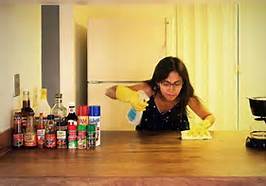 The average child contracts the common cold six to eight times a year, while the average adult contracts the common cold about four or five times a year. There are also many different types of illnesses that assault our immune system. Is there a way to minimize our exposure without shutting ourselves in our homes and sealing ourselves off from the outside world?
The average child contracts the common cold six to eight times a year, while the average adult contracts the common cold about four or five times a year. There are also many different types of illnesses that assault our immune system. Is there a way to minimize our exposure without shutting ourselves in our homes and sealing ourselves off from the outside world?
Choosing the Right Method for the Job
When is it appropriate to clean, disinfect, or sanitize? What is the difference? The Center for Disease Control and Prevention (CDC) website notes the following:
“Cleaning removes germs, dirt, and impurities from surfaces or objects. Cleaning works by using soap (or detergent) and water to physically remove germs from surfaces. This process does not necessarily kill germs, but by removing them, it lowers their numbers and the risk of spreading infection. Disinfecting kills germs on surfaces or objects. Disinfecting works by using chemicals to kill germs on surfaces or objects. This process does not necessarily clean dirty surfaces or remove germs, but by killing germs on a surface after cleaning, it can further lower the risk of spreading infection. Sanitizing lowers the number of germs on surfaces or objects to a safe level, as judged by public health standards or requirements. This process works by either cleaning or disinfecting surfaces or objects to lower the risk of spreading infection,” (cdc.gov, 2010).
According to their standards sanitizing is not much different from cleaning or disinfecting a surface or object. Disinfecting kills germs already present and Cleaning removes germs, dirt, and impurities from surfaces or objects.
Home Sweet Home
The CDC website defined these three terms in relation to cleaning a school, which holds a much larger number of children (roughly 2000) than a private home. The risk of spreading infectious germs between people is significantly lower at home than in a public building; simply cleaning and removing the germs that are present should suffice for most households with healthy inhabitants. The only real reason to disinfect would be if the inhabitants were already ill. We may then place our dishes in the dishwasher rather than wash them by hand to allow the higher temperature water to blast away any residual infectious germs. We want to remove the germs and the dirt and the impurities, that are tracked into our homes and, once there, multiply. Why work extra hard to disinfect when even the CDC is recognizing that this will not remove the impurities and dirt that pass through?
The Best of Both Worlds
An organic cleaner can lower the numberof germs, neutralize the impurities, and at the same time remove the dirt and dust that we bring into our homes! Remembering to wash your light switches, phones, and keyboards; and the everyday surfaces in your kitchen, bedrooms, and bathrooms will greatly minimize contagions and keep your home happy and healthy. You can have a clean home free of contaminants without adding harsh chemicals to the mix!
Applications and Resources
- Find out about the power of white vinegar!
- Check out iGOZEN 100% natural Everyday Cleaner that can clean every surface and is safe for little ones to help
- Discover the secrets of “super healthy” people
iGOZEN is a philosophy and a revolutionary way of living. We seek unity and balance in every aspect of our lives. One of the ways we hope to do this is by sharing with you what we learn through our articles. We believe that making the world a better place doesn’t have to be complicated. A way for you to make the world a better place can be implementing an idea from the article you read, or it can be your decision to try chemical-free iGOZEN Everyday Cleaner or another eco-friendly cleaner.



